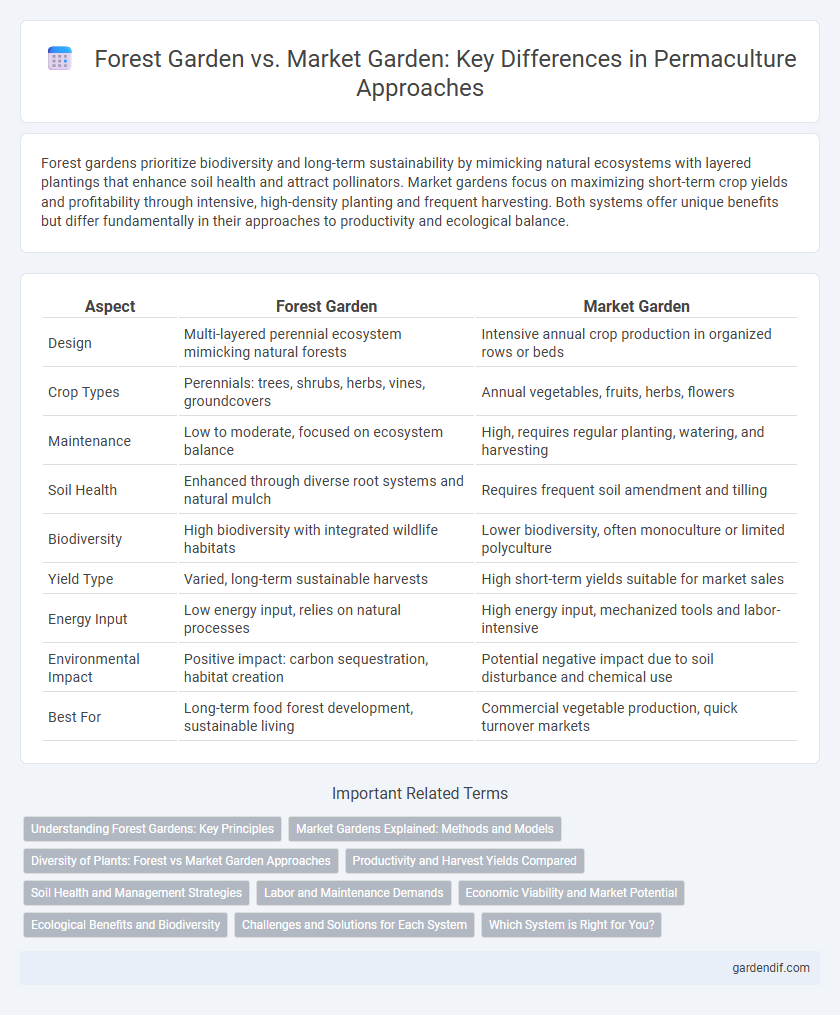
Forest Garden vs Market Garden Illustration
Forest gardens prioritize biodiversity and long-term sustainability by mimicking natural ecosystems with layered plantings that enhance soil health and attract pollinators. Market gardens focus on maximizing short-term crop yields and profitability through intensive, high-density planting and frequent harvesting. Both systems offer unique benefits but differ fundamentally in their approaches to productivity and ecological balance.
Table of Comparison
| Aspect | Forest Garden | Market Garden |
|---|---|---|
| Design | Multi-layered perennial ecosystem mimicking natural forests | Intensive annual crop production in organized rows or beds |
| Crop Types | Perennials: trees, shrubs, herbs, vines, groundcovers | Annual vegetables, fruits, herbs, flowers |
| Maintenance | Low to moderate, focused on ecosystem balance | High, requires regular planting, watering, and harvesting |
| Soil Health | Enhanced through diverse root systems and natural mulch | Requires frequent soil amendment and tilling |
| Biodiversity | High biodiversity with integrated wildlife habitats | Lower biodiversity, often monoculture or limited polyculture |
| Yield Type | Varied, long-term sustainable harvests | High short-term yields suitable for market sales |
| Energy Input | Low energy input, relies on natural processes | High energy input, mechanized tools and labor-intensive |
| Environmental Impact | Positive impact: carbon sequestration, habitat creation | Potential negative impact due to soil disturbance and chemical use |
| Best For | Long-term food forest development, sustainable living | Commercial vegetable production, quick turnover markets |
Understanding Forest Gardens: Key Principles
Forest gardens embody the core principles of permaculture by mimicking natural ecosystems through multi-layered planting that includes trees, shrubs, herbs, and groundcovers, enhancing biodiversity and soil health. They prioritize perennial plants and self-sustaining systems, reducing the need for external inputs like fertilizers and pesticides common in conventional market gardening. This approach fosters resilient food production by integrating ecological functions such as nitrogen fixation, water retention, and habitat creation, distinguishing it fundamentally from the annual-focused, intensive cultivation practices of market gardens.
Market Gardens Explained: Methods and Models
Market gardens employ intensive cultivation techniques on small plots, maximizing yield through crop diversity, succession planting, and season extension methods. Common models include biointensive gardening, permaculture-based polycultures, and no-till farming, which enhance soil health while reducing external inputs. These methods prioritize efficient space use, high-value crops, and sustainable practices to meet local food demands.
Diversity of Plants: Forest vs Market Garden Approaches
Forest gardens prioritize a multi-layered diversity of perennial plants, including trees, shrubs, herbs, and ground covers that mimic natural ecosystems to enhance resilience and biodiversity. Market gardens focus on annual crop diversity with fast-growing vegetables and herbs, optimized for high yield and seasonal turnover. The forest garden approach fosters long-term ecological stability, while the market garden emphasizes intensive production and crop rotation.
Productivity and Harvest Yields Compared
Forest gardens maximize productivity through diverse layers of perennial plants, improving soil health and yielding fruits, nuts, and medicinal herbs year-round. Market gardens focus on intensive cultivation of annual vegetables and herbs, generating higher immediate yields per square foot with faster turnover cycles. While forest gardens invest in long-term ecological stability and continuous harvests, market gardens optimize short-term productivity and market-driven crop diversity.
Soil Health and Management Strategies
Forest gardens prioritize diverse, perennial plants that enhance soil structure and promote microbial activity through leaf litter and root systems, fostering long-term soil fertility. Market gardens rely on intensive annual crops with regular soil disturbance, often requiring compost amendments and crop rotation to maintain nutrient levels and prevent erosion. Integrating agroforestry principles from forest gardens into market gardening can improve soil health by increasing organic matter and reducing dependency on external inputs.
Labor and Maintenance Demands
Forest gardens require low labor and minimal maintenance due to their perennial plant systems that self-regulate and improve soil health over time. Market gardens demand higher labor input with frequent planting, weeding, irrigation, and harvesting to sustain annual crops and meet commercial production goals. The intensive management of market gardens contrasts sharply with the labor-efficient, resilient design of forest gardens.
Economic Viability and Market Potential
Forest gardens optimize long-term economic viability by integrating diverse perennial crops that reduce input costs and increase resilience against market fluctuations. Market gardens focus on short-term cash flow through high-yield annual vegetable production, offering rapid returns but requiring continuous labor and inputs. The market potential for forest gardens lies in niche products like specialty fruits and medicinal plants, while market gardens target broader consumer demand through fresh produce sales.
Ecological Benefits and Biodiversity
Forest gardens enhance ecological benefits by mimicking natural ecosystems, promoting soil health, carbon sequestration, and supporting diverse wildlife habitats. Market gardens, while efficient for food production, often rely on monoculture practices that can reduce biodiversity and soil fertility over time. Integrating a forest garden approach within market gardens can improve biodiversity, pest control, and ecosystem resilience.
Challenges and Solutions for Each System
Forest gardens face challenges such as managing diverse plant species and maintaining soil fertility under varying shade conditions. Solutions include layering plants for optimal light capture and using mulch to preserve moisture and enhance soil nutrients. Market gardens struggle with intensive labor and pest control; adopting crop rotation and integrated pest management improves productivity and sustainability.
Which System is Right for You?
Forest gardens emphasize perennial plants, biodiversity, and low-maintenance ecosystems ideal for sustainable food production with minimal labor. Market gardens prioritize annual crops, intensive planting, and high yields suited for commercial sales and short-term profits. Choosing the right system depends on your goals: long-term ecological resilience versus quick market returns and crop turnover.
Forest Garden vs Market Garden Infographic

 gardendif.com
gardendif.com